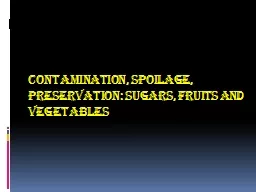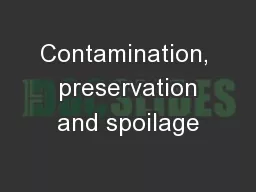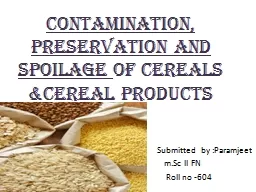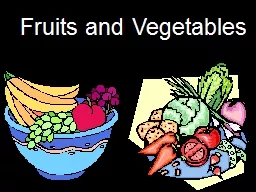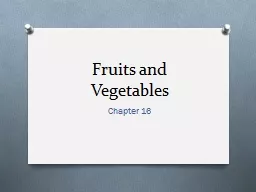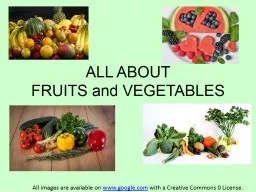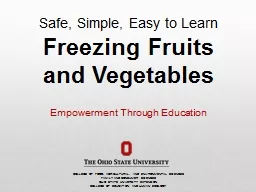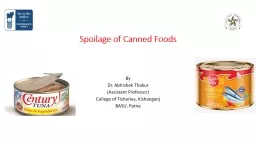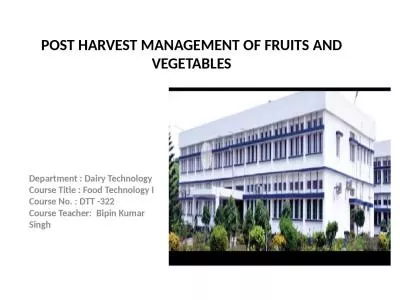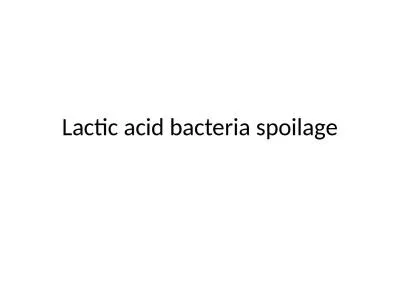PPT-Contamination, Spoilage, Preservation: Sugars, Fruits and Vegetables
Author : ellena-manuel | Published Date : 2018-03-08
CONTAMINATION OF SUGARS Sugar products include sucrose cane and beet sugar molasses syrups maple sap and sugar honey and candy SUCROSE The raw juice expressed
Presentation Embed Code
Download Presentation
Download Presentation The PPT/PDF document "Contamination, Spoilage, Preservation: S..." is the property of its rightful owner. Permission is granted to download and print the materials on this website for personal, non-commercial use only, and to display it on your personal computer provided you do not modify the materials and that you retain all copyright notices contained in the materials. By downloading content from our website, you accept the terms of this agreement.
Contamination, Spoilage, Preservation: Sugars, Fruits and Vegetables: Transcript
CONTAMINATION OF SUGARS Sugar products include sucrose cane and beet sugar molasses syrups maple sap and sugar honey and candy SUCROSE The raw juice expressed from sugarcane may become high in microbial content unless processing is prompt. Varun. . Pathak. School of Biomedical Sciences,. University of Ulster,. Coleraine. Hunter-Gatherer society. supported low numbers/ self-sufficient. unreliable food supply. limited specialisation of individuals. of cereals &cereal products. . CONTAMINATION. The exteriors of harvested grains retains some of the natural flora they had while growing plus contamination from soil ,insects & other sources. . of cereals &cereal products. Submitted by :. P. aramjeet . m.Sc II FN. Roll no -604. CONTAMINATION. The exteriors of harvested grains retains some of the natural flora they had while growing plus contamination from soil ,insects & other sources. . SMSD. Mrs. Rohret. Fruits and Vegetables. Important source of dietary fiber and carbohydrates. They are rich in vitamins & minerals. Fruits & Veggies are:. Low in fat. low in calories. low in sodium. Dietary Guidelines. Make half your plate fruits & vegetables. Choose fresh, frozen, canned or dried fruits and vegetables. Eat red, orange, and . dark . green vegetables, such as tomatoes, sweet potatoes and broccoli in main and side dishes. Chapter 16. Bell Ringer. January 11. th. , 2012. What have you learned about fruits and vegetables so far?. Definition of a fruit. Botanical: ripened enlarged ovaries and parts of a plant’s flowers. Catalogue for Reynolds Fruit and Vegetable Wholesaler. Summer a& Autumn 2018. https://www.reynolds-cs.com Did You Know?. What is the fruit or vegetable consumed most by Americans?. Some common “vegetables” are actually fruits. How many can you name?. Which fruit typically contains more than 200 seeds?. Did You Know?. What is the fruit or vegetable consumed most by Americans?. Some common “vegetables” are actually fruits. How many can you name?. Which fruit typically contains more than 200 seeds?. All images are available on . www.google.com. with a Creative Commons 0 License.. Why should we eat FRUIT? . Fruits are high in:. Vitamins A & C. Fiber. Carbohydrates. Potassium. Fruits are low in:. Freezing . Fruits and Vegetables. Empowerment Through Education. Today’s Topics. Basics of freezing fruits and vegetables. Preventing fruits from discoloring. Blanching vegetables. Packaging frozen fruits and vegetables. By . Dr. Abhishek Thakur. (Assistant Professor). College of Fisheries, Kishanganj. BASU, Patna. Subject: Fish Canning Technology. Date of Lecture: . 22.06.2020 & 06.07.2020. Food Spoilage. Food spoilage can be defined as . Department : Dairy Technology. Course Title : Food Technology I. Course No. : DTT -322. Course Teacher: . Bipin. Kumar Singh. Introduction. Fruits and vegetables, fresh or processed, form an important component of our diet and there is an . What are LABs?. Lactococcus. sp.. Lactobacillus. sp.. Leuconostoc. sp.. Pediococcus. sp.. Oenococcus. sp.. Streptococcus. sp.. Enterococcus. sp.. Sporolactobacillus. sp.. Carnobacterium. sp..
Download Document
Here is the link to download the presentation.
"Contamination, Spoilage, Preservation: Sugars, Fruits and Vegetables"The content belongs to its owner. You may download and print it for personal use, without modification, and keep all copyright notices. By downloading, you agree to these terms.
Related Documents

